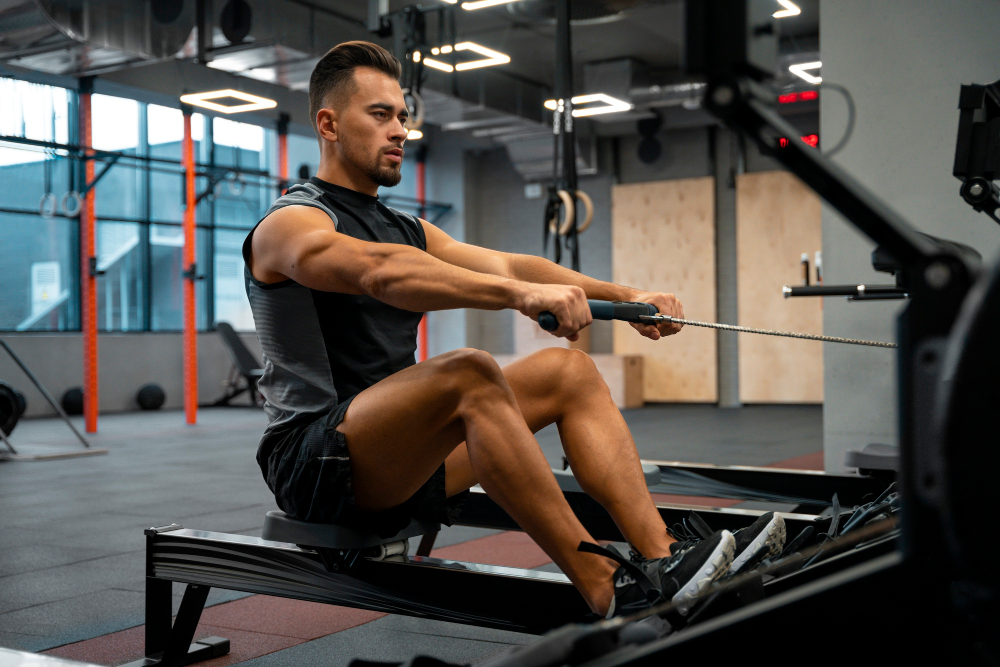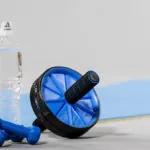Look around any gym and you’ll see the same thing: treadmills lined up, ellipticals grinding away, and someone sweating on a stair climber. Meanwhile, the rowing machine sits in the corner, collecting dust.
But if you’re serious about burning fat, building cardio endurance, and hitting multiple muscle groups at once, the rower is your sleeper pick. And when you combine it with HIIT (high-intensity interval training), it turns into a full-body workout.
So let’s take a look at a HIIT rowing workout for beginners, how to organize it, and what you should keep in mind.
Why is Rowing a Great Exercise?
Every time you pull that handle, you’re using your legs, core, back, shoulders, and arms. And not in some half-hearted, accessory way. This is a full-body, compound movement that torches calories while also building power and endurance.
It hits over 85% of your muscles per stroke. Name one other machine that does that without smashing your joints. You won’t find it.
It’s also low-impact, which means you can push yourself without wrecking your knees or ankles. That’s a huge win if you’re new, coming off an injury, or just tired of grinding out painful runs.
And here’s the kicker: rowing doesn’t just burn calories during the workout, it sets you up for a stronger afterburn (thanks to HIIT).
Mistakes to Avoid During a HIIT Rowing Workout for Beginners
Rowing looks easy. It’s not. And that’s where beginners mess up.
Mistake #1: Pulling with Your Arms First
This is the classic rookie move. Rowing is a leg-driven movement. Your legs should start the stroke, your core transfers the power, and your arms finish it off. If you yank with your arms from the start, not only do you waste power, you wreck your form and risk shoulder and back strain.
Mistake #2: Rushing the Recovery
The drive (pushing back) should be explosive. The recovery (coming forward) should be controlled. But most beginners blast through both parts like they’re sprinting downhill. That kills your rhythm, jacks up your heart rate too fast, and ruins efficiency.
Mistake #3: Terrible Posture
Slouched spine, shoulders hunched, head down, it’s a disaster waiting to happen. If your back isn’t straight and braced, you’re not just wasting effort. You’re setting yourself up for lower back pain.
Mistake #4: Cranking the Resistance All the Way Up
More resistance doesn’t mean better results. Most rowers use a damper setting, not a “difficulty level.” High damper = heavier stroke = more strain, not more fat loss. Start moderate and focus on form first.
How to Row (Properly)
The rowing stroke has four parts:
- Catch: You’re at the front of the machine. Knees bent, shins vertical, arms straight, back slightly forward but flat. Eyes forward, not down.
- Drive: Push hard through your legs first. Then lean your torso back slightly. Then pull the handle to your chest (below your ribs, not up by your neck).
Order: Legs, Core, Arms
- Finish: You’re at the back. Legs straight, body leaning slightly back, handle at your chest, elbows in. Breathe.
- Recovery: Let the handle go first (arms straight), then lean forward, then bend your knees to glide back to the front.
Order: Arms, Core, Legs
If there comes a day you don’t have access to a rowing machine at your gym, try these HIIT sprint workouts.
Example of a HIIT Rowing Workout for Beginners
Here’s a simple but brutally effective beginner HIIT workout to get you started:
The “20/40 x 8” Workout
- 20 seconds all-out effort
- 40 seconds full rest or light rowing
- Repeat for 8 rounds (total: 8 minutes of intervals)
Warm-Up (5 min):
- Start with easy rowing
- Add 10-second bursts to gradually increase intensity
- Practice the stroke rhythm
Main Set (8 min):
- During the 20 seconds: row as hard as you can with good form
- During the 40 seconds: either rest completely or row slowly to recover
Cooldown (5-10 min):
- Light rowing
- Stretch your hamstrings, quads, and back
How Often Should You Do This?
Start with 2 times per week. That’s plenty if you’re new and want to stay consistent without burning out or wrecking your form.
Rowing is intense. It works your whole body. It needs recovery time, especially when paired with HIIT.
Once you’re confident in your form and recovery is solid, you can go to 3 sessions per week, spacing them out.
If you’re not sure if rowing is the best option for you, check out our comparison with a stationary bike.
Final Thoughts
It’s not trendy. It’s not loud. But it works. Rowing, especially when paired with HIIT, delivers serious fat-burning power, full-body conditioning, and cardio without wrecking your joints. It’s efficient, it’s effective, and it’s way more than just “pulling a handle.”
Start simple. Master your form. Keep your intervals sharp. And most importantly, don’t treat the rower like background equipment. Use it with intent, and you’ll feel the difference fast.





